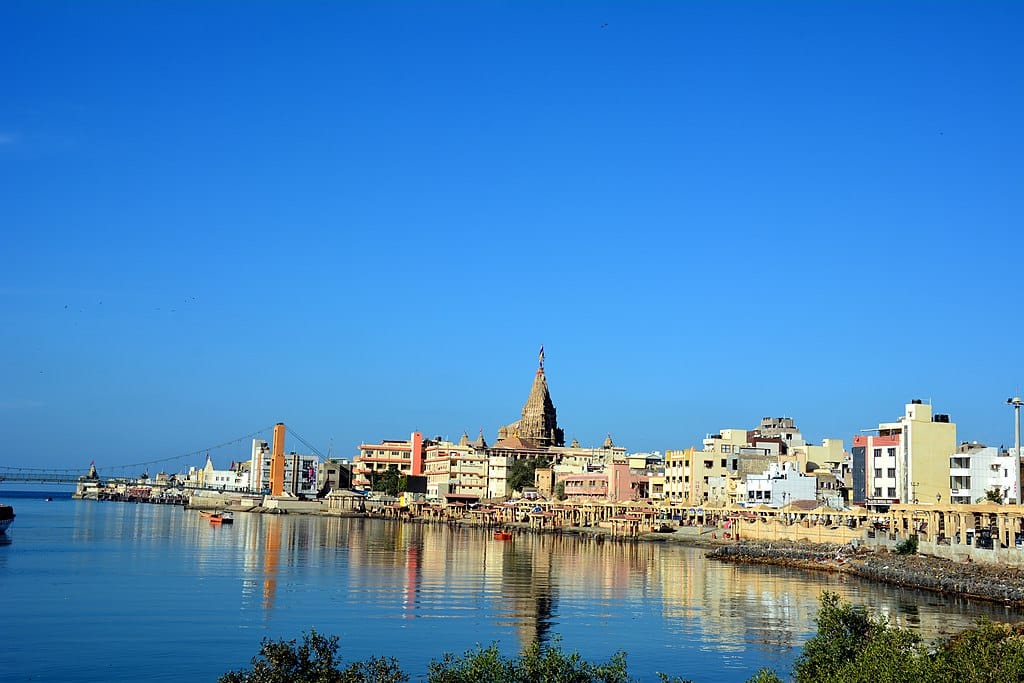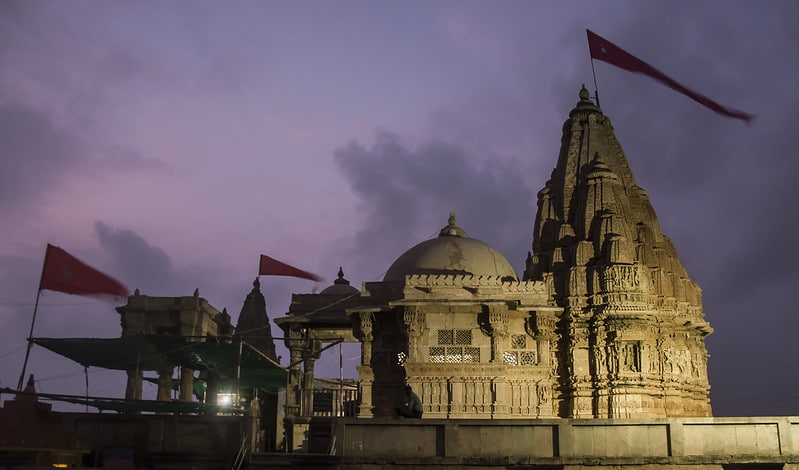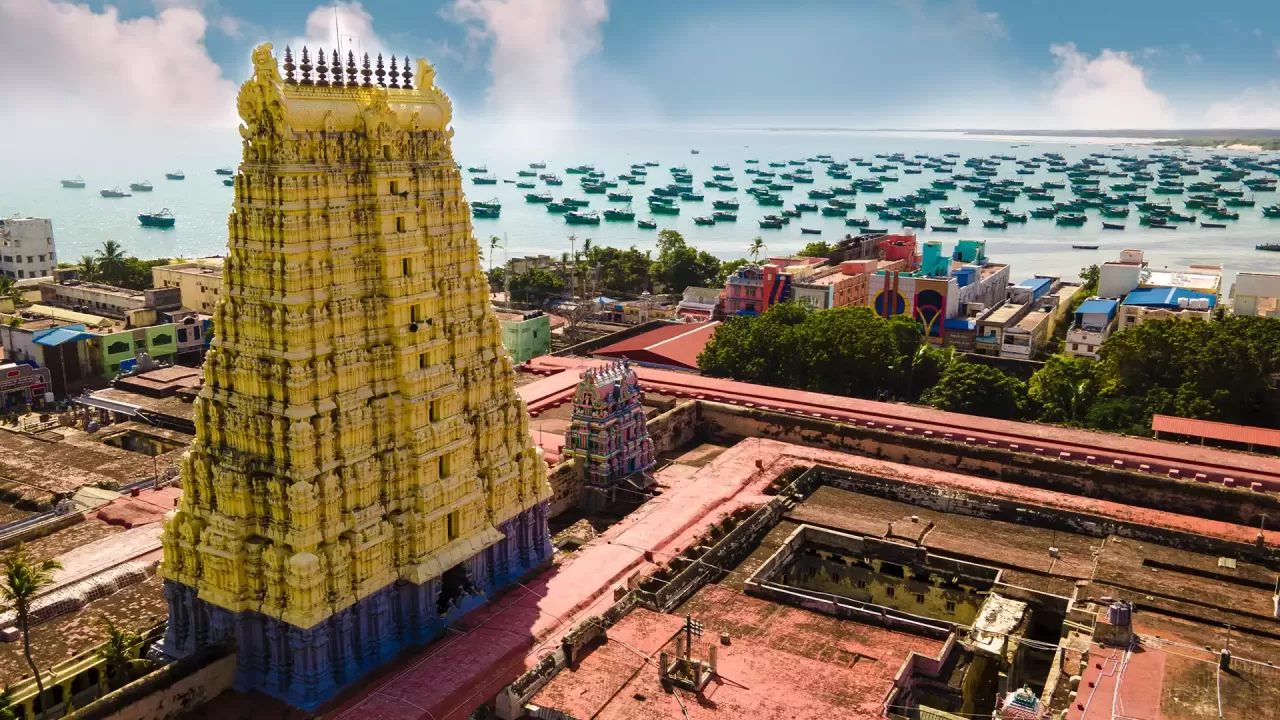Dwarka, one of India’s seven holy pilgrimage sites, is not only religiously significant but also archaeologically substantial. Located at the western tip of the Saurashtra peninsula in the state of Gujarat, Dwarka has great importance both as one of the four principal holy places. It is also one of the seven holy towns to visit. However, Dwarka’s archaeological and historical background is shrouded in mystery. The city’s earliest incarnation, known as the “ancient kingdom of Krishna” in the epic Mahabharata, was spread across nearly 84 km as a fortified city where the Gomti River and the Arabian Sea met. When Krishna died, it was assumed that the ancient city sank beneath the Arabian Sea. Historians and archaeologists are diving to find evidence proving the existence of Krishna’s majestic kingdom, the lost city of Dwarka.
The sunken city of Dwarka – A legend or a myth?
The most famous legend about the lost city of Dwarka can be found in the ancient epic of Mahabharata. Dwarka, like Atlantis, is said to have sunk beneath the sea at some point in the distant past. However, unlike Atlantis, whose remains have never been discovered, remnants of this ancient kingdom could be found in the depths.
If you are wondering why Dwarka submerged in water, according to the sacred scripture of Srimad Bhagavatam, the city of Dwaraka was built in response to Jarasandha, the ruler of Magadha, who was constantly attacking Mathura. To prevent further attacks on his clan, Lord Krishna decided to establish a separate city on India’s western coast. The great architect Vishwakarma gave this concept life. The submerged city of Dwarka was built by Krishna near a place called Kushasthali, according to ancient texts. The city quickly rose to prominence and became the unstoppable pivot of Lord Krishna’s mission, housing thousands in approximately 900 palaces. The city was heavily fortified and could only be reached by ship. The lost city of Dwarka quickly became a talking point around the world, inspiring awe and wonder.

According to the Mahabharata’s 23rd and 34th stanzas, the city was inundated and submerged by the Arabian Sea on the same day that Krishna departed the Earth to join the spiritual world after 125 years, and this is when the Kali age began. The ocean’s deity reclaimed the land, sinking lost city of Dwarka but sparing Lord Krishna’s palace. It is also said that lost city of Dwarka was attacked by Vimana, a flying machine.
The description of the fight piques the interest of ancient alien theories, as it appears to imply that it was fought with sophisticated technology and powerful weapons, possibly even from orbit. The spacecraft launched an attack on the city using energy weaponry, which resembled a lightning strike to onlookers, and it was so devastating that much of the city lay in ruins following the attack.
Until recently, the submerged city of Dwarka history was only a matter of folklore. The question “is Dwarka real” was constantly asked. Could it be that Lord Krishna and his aerial fight were more than just a legend now that the remains have been discovered underwater and with many signs pointing to this being the famous Dwarka, the residence site of Lord Krishna?
The search for the submerged kingdom
The initial excavations began about 100 years ago, in the 1930s, around the island of Bet Dwarka, located approximately 30 kilometres north of modern-day Dwarka in Gujarat’s Jamnagar district. More excavations were carried out in the 1960s, but no definitive results were obtained. In 1979, the Archeological Survey of India conducted another excavation. During this, the excavator discovered pottery dating from the second millennium BC.

Archaeologists discovered a building that appeared to be a fortified foundation. This suggests that the ancient city walls must have been built along the river banks between 1983 and 1990. Over 500 antiques were unearthed from the site. Some samples and date elements strongly establish the 2000-year cultural succession. Stone blocks, pillars, and irrigation systems were discovered, although the actual date of these discoveries is still being contested.
According to Dr Rajiv Nigam, former chief scientist-CSIR-NIO, the process of underwater exploration began with excavation near the current Dwarkadhish temple (Council of Scientific and Industrial Research- National Institute of Oceanography). The Dwarka mandir was built during the 13th and 15th centuries BCE. Dr S R Rao, a well-known Indian archaeologist, conducted an offshore survey to look for signs of the submerged metropolis and a full excavation was carried out in 2007. He explained that the location of Dwarka on the westernmost tip of India, in modern-day Gujarat, corresponds to one given in the written literature.
The archaeological findings
According to one theory, the lost city of Dwarka was built on reclaimed land roughly 3500 years ago and was drowned in water when sea levels rose. Scientific studies have revealed that the sea level in the area has risen and decreased numerous times before reaching its current levels in 1000 CE. These changing sea levels could be caused by anything from geological disturbances to coastal erosion.
A great number of anchors were discovered in this location during Dwarka underwater archaeology. It indicated that Dwarka under sea was a historic port. History reveals that it must have played a role in trading contacts between Indian and Arabic regions from the 15th to 18th century, and the harbour area was previously utilised for anchoring vessels. The word ‘Dwarka’ means ‘ portal’ or ‘door’ in Sanskrit, hinting that this ancient port city. It may have served as an access point for foreign mariners coming to India. Archaeologists are now preparing an underwater dig to hunt for the ancient city walls’ foundations.
Things to do in Dwarka
Dwarka is an important pilgrimage spot which holds great value in Indian mythology. It is one of the places for the sacred Char Dham Yatra. Every year, thousands of pilgrims flock to Dwarka to worship Krishna. The best way to explore Dwarka comfortably is by booking a taxi from Ahmedabad. Here are some of the best things to do in Dwarka.
- Witness unique practices at Shree Dwarkadhish Temple – The Dwarka Gujarat temple flag is changed five times a day. This is not done in any other temple in India.
- Visit the Gopi Talav – This is the place where Lord Krishna used to play with his Gopis.
- Observe the ancient tradition of Tulabhara – Tulabhara is an ancient Indian practice in which a human being is put to sit on a weighing scale against items. A human will be on one end of the weighing scale, while grains will be on the other. When the weight of the grains equals the individual’s weight, they donate the grains to the temple.
- Ride a camel along the Gomti River – Seeing the Ghats on one bank while riding a camel on the other is an unforgettable experience.
- Go souvenir shopping at Dwarkadhish Market – The city is filled with artists, and there are many souvenirs to be found. The Chakrashila, a wheel-like stone found in the sea, the statue of Dwarkadheesh, and the Gopi Chandan sticks are among the most famous trinkets.
- Dwarka Beach: Situated along the Arabian Sea coastline, Dwarka Beach offers a rejuvenating experience in the sacred coastal town of Dwarka. The beach features stunning coral reefs and is adorned with ancient temples dating back to the 1100s and 1200s.
- Visit the Light House – The Light House is a well-known landmark on Dwarka’s seacoast. Behind the Lighthouse is a massive cave beneath the coast formed naturally by the striking of seawater.
Best time to visit Dwarka
Dwarka is best visited between November and the end of February when the city experiences chilly winters. Dwarka grandly celebrates Janmashtami Festival, so visiting the town between August and September will be worthwhile. As a result, the months of September to March are ideal for visiting Dwarka. However, the city is equally enchanting all year.
How to get there
By air: The nearest airport is Porbandar Airport, which is about 96 km away from Dwarka. You can book a cab from the Porbandar airport to cover the Dwarka distance. You can then comfortably commute to your accommodation in Dwarka. Yet another airport is the Jamnagar airport which is farther, at about 115 km.
By road: Dwarka is well-connected with many of the major cities and towns around it by a lot of buses. The best way to travel to the holy city is by booking a cab from Ahmedabad.
Every traveller should put the lost city of Dwarka on their itinerary if they want to experience a mix of India’s spirituality and mysticism. Don’t worry about how to head back to the airport or railway station after your trip. The easiest way is to download a safe and trusted car booking app so that on your way back, the only thing on your mind is all the memories you’re going to carry throughout your life!
Last Updated on May 15, 2024 by Shabari Shankar





